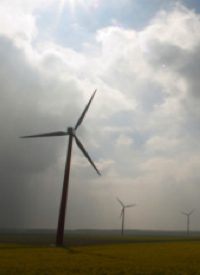
Legislative efforts to implement a supposedly “environmentally friendly” conversion of the U.S. economy by means of carbon credits may be on hold for the moment, but that does not mean that a shift toward solar and wind power is not underway. The motivation for the trend is supposedly profit, not ideology.
On August 23, Washington Post reporter Matthew Brown had voiced the typical environmentalist "concerns" over plans to construct more coal plants to generate the power to meet America’s growing energy needs:
Utilities across the country are building dozens of old-style coal plants that will cement the industry’s standing as the largest industrial source of climate-changing gases for years to come.
An Associated Press examination of Energy Department records and information provided by utilities and trade groups shows that more than 30 traditional coal plants have been built since 2008 or are under construction.
The construction wave stretches across the country and comes despite growing public wariness over the high environmental and social costs of fossil fuels, demonstrated by mine disasters in West Virginia and the gulf oil spill.
How, precisely, the gulf oil leak could be considered apropos to an article on coal plants — other than under the heading of general environmental alarmism — is unclear; that any sort of mining is dangerous is hardly breaking news, since mining has been known to be hazardous work since the days before the Roman Empire. If the choice of “social costs” was a balance between the hazards of mining, and the effect of widespread brownouts and blackouts due to power shortages, what would the public’s mindset be? And if the measure of environmental costs is in terms of carbon dioxide, the science supporting such claims remains far from conclusive.
However, according to an article by Mindy Lubber (“The US Power Sector is Changing — Even Without a Climate Bill”) distributed by Reuters, there is, in fact, a demonstrable shift from coal-fired power plants to solar and wind-power generation taking place. Specifically, Lubber takes issue with the previously-cited Washington Post article and responds to a major flaw that she perceives in Brown’s article:
But there was an important context missing: The article failed to note that wind power production was the largest source of new electricity in the US last year and that for every new coal plant built in the US in recent years, four proposed coal plants have been canceled or delayed.
The reality is the US power sector is undergoing a dramatic transformation to decarbonize its energy offerings and sell less, not more, electricity.
Lubber’s observations are hardly earthshaking news for anyone who has travelled in the American southwest in recent years and seen the transformation of the landscape that has taken place; for example, wind turbines cover western Texas like some sort of surreal forest "canopy" extending over an undergrowth of pump jack oil wells. And the motivating force behind the growth of wind power has been the potential for profit, combined with regulatory disincentives already in place, which discourage continued development of so-called “fossil fuels.” Again, In Lubber’s words:
Even without climate legislation, other market forces are compelling the industry to change. Wind and other forms of renewable energy are becoming more cost-competitive with fossil-fuel based generation, and states are setting aggressive renewable energy targets while the federal government provides financial incentives. Energy efficiency is gaining regulatory support as the lowest-cost option for meeting energy demand. Environmental rules for limiting mercury, SO2 and other air pollutants are getting tighter. And with climate legislation stalled, EPA greenhouse gas regulations are looming.
One may, of course, take issue with Lubber’s redefinition of certain terms: after all, regulatory interference means that, by definition, “the lowest-cost option” is not being pursued. Rather, businesses will attempt to find the lowest cost that is still available to them, in light of regulations that restrict their ability to pursue options that would otherwise prove more economically viable. The EPA’s bizarre effort to regulate carbon dioxide is proof of an agency operating outside of mandate, and possibly outside of reality itself.
However, Lubber is not content with the development of alternative energy to which her article bears witness, and argues that the “answer” is, in the end, still more regulation:
What’s required now is continued support that accelerates the development of renewable energy and new EPA pollution rules that spur innovation in the power sector.
The long-term solution, however, is in the hands of Congress. The longer it delays passing national legislation to reduce carbon emissions and provide clarity for the industry, the greater the temptation for utilities to cling to the past with old dirty technologies — stalling the promising paradigm shift now sweeping the industry.
Mindy Lubber is president of Ceres, which describes itself as “a national network of investors, environmental organizations and other public interest groups working with companies and investors to address sustainability challenges such as global climate change.”
If the desired effect is already taking place without further regulation, why press for continued regulation? One thing seems certain: Government regulation of any aspect of the economy means that government, not market forces, will pick “winners” and “losers” on the basis of criteria that have little to do with efficiency or the quality of the product being brought to market. Environmental regulation will not mean cheaper power, or a better supply of power, but the regulation will determine what it means to be a “winner” in a power industry governed by the principles of radical environmentalism.



